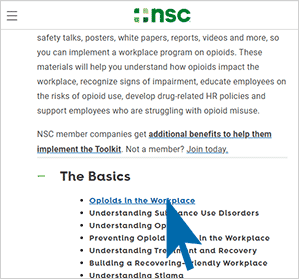Opioids and the workforce
COVID-19 pandemic-related disruptions create new hurdles

After years of providing resources to workers facing challenges related to opioid use, the Keystone Contractors Association was “trending in the right direction” with regard to the number of employees asking for assistance and receiving help.
But then “2020 came along and screwed everything up,” said Jon O’Brien, executive director of the statewide commercial construction trade association in Pennsylvania. “In a way, it feels like we might be back to square one.”
For O’Brien and others dedicated to worker safety and health, the far-reaching impact of the COVID-19 pandemic has caused plenty of concern about opioids.
On June 9, the National Safety Council issued a statement calling on employers to prioritize employee stress and mental health. The council warned that heightened stress and mental health issues related to the pandemic among workers would likely lead to an increase in substance misuse.
“(It) could be a serious threat to worker safety and cost tens of thousands in productivity losses, absenteeism and presenteeism, and worker’s compensation claims,” NSC cautioned.
Stark statistics
Provisional data released in December by the Centers for Disease Control and Prevention underscores NSC’s warning. In the 12-month period ending in May 2020, 81,230 drug overdose deaths were recorded – the highest number ever recorded in such a time frame.
Calling it a “concerning acceleration” of overdose deaths, CDC noted rapid increases involving synthetic opioids, “likely illicitly manufactured fentanyl.”
According to NIOSH, 37% of all opioid overdose deaths involve a prescription drug.

“With opioids, we want people to use them safely if they’re prescribed them,” she said. “We’re not trying to prevent all use.”
The difficulty faced by many workers was that 2020 was anything but normal.
“The biggest challenge was the disruption to daily life,” O’Brien said. “We have workers seeking help, seeking treatment. They might go to meetings or even training.”
However, many recovery centers had to change their usual in-person recovery meetings and numerous training centers had to close to mitigate the spread of COVID-19. Those changes in particular, O’Brien said, took away everyday support systems from workers who rely on them.
That loss, along with uncertain employment situations, caused immeasurable stress for some – and continues to do so.
“The stress has been something else,” Cooper said. “If you happen to be in one of the models of recovery that has a lot of in-person meetings, all of a sudden that support got taken out from under you.
“And, there’s incredible isolation. That’s an increased risk factor for relapse, and relapses are extraordinarily dangerous in terms of potential for overdose. People who have not been using for a while, their bodies aren’t used to using anymore.”
With some workers more isolated, telling a friend, family member or colleague about their opioid issues isn’t as likely, Cooper added.
“When people feel isolated or embarrassed or ashamed of what they’re doing, they’re not going to tell somebody what’s going on,” she said. “Then, people aren’t going to know. People can’t intervene.”
Post a comment to this article
Safety+Health welcomes comments that promote respectful dialogue. Please stay on topic. Comments that contain personal attacks, profanity or abusive language – or those aggressively promoting products or services – will be removed. We reserve the right to determine which comments violate our comment policy. (Anonymous comments are welcome; merely skip the “name” field in the comment box. An email address is required but will not be included with your comment.)

